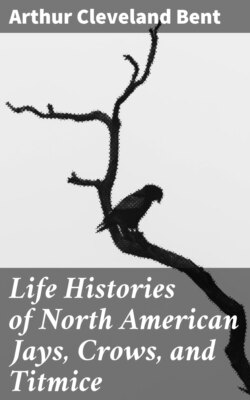Читать книгу Life Histories of North American Jays, Crows, and Titmice - Arthur Cleveland Bent - Страница 35
На сайте Литреса книга снята с продажи.
CYANOCITTA STELLERI ANNECTENS (Baird)
BLACK-HEADED JAY
ОглавлениеTable of Contents
The crested jay of the northern Rocky Mountain region is apparently a connecting link between the long-crested jay (diademata) to the southward and Steller’s jay (stelleri) to the westward, as it combines some of the characters of both races, in about equal proportions in the center of its range. Baird recognized this fact when he suggested the appropriate name of annectens (Baird, Brewer, and Ridgway, 1874). However, as it is an abundant form, covering a considerable range, it may be well to give it subspecific status, rather than to consider it as merely an intermediate, which, in fact, it really is.
Ridgway (1904) describes it as “similar to C. s. stelleri, but with a distinct (though sometimes small) elongated spot of grayish white immediately above the eye; streaks on forehead (if present) paler blue or bluish white; chin and upper throat more conspicuously streaked (the streaks grayish white rather than gray); back and scapulars rather paler and grayer, and the blue of rump, upper tail-coverts, and under parts of body paler and greener (nearly verditer or china blue).”
The 1931 Check-list gives the range of this race as the “Boreal and Transition zones of the Rocky Mountains from British Columbia south to eastern Oregon, Idaho, and Wyoming.” This is probably the main breeding range of typical annectens, but it evidently intergrades gradually into typical stelleri from eastern British Columbia westward, and into diademata from southern Wyoming southward. Major Bendire (1895) sent 11 skins, taken near Walla Walla, Wash., to William Brewster, “who pronounced five of them typical Cyanocitta stelleri annectens, and two nearly typical Cyanocitta stelleri, and four intermediate between these two forms.”
I cannot find that the black-headed jay differs materially in its haunts or in any of its habits from other races of the species. J. A. Munro, who has sent me some notes on it, says that in British Columbia it breeds in the Canadian Zone above 3,500 feet and comes down to the lake region in October, remaining until May. Seldom more than three or four are seen in a day’s walk. There is apparently a limited migration from the northern part of its range, both southward and eastward, perhaps nearly or quite to the coast. He has heard it give the tremolo call of the loon and a perfect imitation of the redtail’s scream, as well as the call of the raven. He says that black-headed jays were common all through the winter of 1921-22 about Okanagan Landing, wintering in the shore brush and coming to the kitchen door for scraps that were thrown out. He says that they are very curious and come readily to the pygmy-owl call.
The eggs are indistinguishable from those of other races of the species. The measurements of six eggs in the United States National Museum average 30.7 by 22.0 millimeters; the eggs showing the four extremes measure 31.8 by 21.6, 30.3 by 23.1, 29.5 by 21.6, and 31.3 by 21.1 millimeters.
